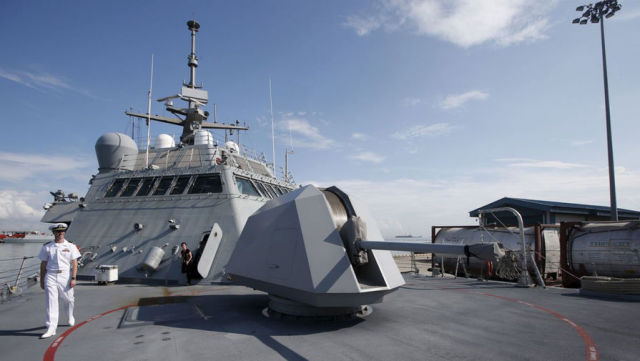US Navy stops supply of Freedom-class coastal zone ships
The US Navy has suspended deliveries of the Lockheed Martin Corporation's Freedom-class coastal zone ship. The reason for the rejection of the vessel was a structural defect in the power transmission. This is not the first problem faced by American shipbuilders in recent years, which causes wariness in the expert community.
In a statement to Defense News, the U.S. Navy pointed to a "material defect" in the Freedom LCS ' complex powertrain, which transmits the power generated by the engines to their water-jet propulsion system, and said it was working to eliminate the shortcomings noted.
The identified defects will be corrected on ships already in the US Navy. Only after these issues are resolved can new LCS be delivered.
The Freedom ship has two Rolls-Royce gas turbine engines with a capacity of 48,000 hp and two Colt-Pielstick diesel engines with a capacity of 9,100 hp-a total of 57 thousand hp And all this power must be transferred to the ship's water jet propulsion systems.
At the end of 2020 revealed that the main gears that transmitted power from the main power plants (geu) and auxiliary power units (WPU) ships of this type have a fatal design flaw - they cannot withstand the load clutch bearings and gearboxes being destroyed when working with gems.
To date, the shipbuilders have handed over ten Freedom-class ships to the US Navy, and five more are under construction.
The Freedom LCS was designed by Lockheed Martin and built at the Fincantieri Marinette Marine shipyard. The combined power transmission system with the recently identified defect was created by the German company RENK AG. The U.S. Navy, Lockheed Corporation, and RENK AG are currently working together to address the identified deficiencies. This process is likely to take at least months.
"The modified power transfer design from the main power plant to the water jet propulsion systems will be tested at the RENK AG plant and on a new ship at sea before it is adopted by the Navy," said Rear Admiral Casey Moton, head of the Unmanned and Small Combat Units Division at the US Navy's Marine Systems Command.
According to a senior navy official, the Navy told Lockheed Martin that the revealed flaws in the power transmission system are a " latent defect."
Lockheed has not yet responded to the Navy, and no agreement has yet been reached on how the repairs will be paid for.
How much this repair will cost is still unknown, said the representative of the Assistant Secretary of the Navy for Research, Development and Procurement, Captain 1st Rank Danny Hernandez.
"The cost of the repairs will be determined after a solution approved by the government is found," Hernandez explained.
Lockheed Martin stressed in its statement that it intends to solve the problem of power transmission design on Freedom ships. "In cooperation with the U.S. Navy, Lockheed Martin is aggressively pursuing a solution to the equipment problem currently facing Freedom - class coastal ships," the company said.
The US Navy has issued a temporary operating manual that restricts some of the ship's functions. A source familiar with the situation told Defense News that according to the project, the ship can reach speeds of up to 34 knots even with restrictions in various configurations. The recommendations limit some of the ship's operating modes, which cause stress on the faulty bearings of the power transmission system, two sources confirmed to Defense News.
A string of power transmission system accidents dates back to 2015, when LCS Milwaukee failed during its first sea crossing to home base Mayport, Florida, and had to be towed to Little Creek Base in Hampton Roads, Virginia.
At the beginning of the following year, the power transmission system suffered while the ship was still in port, when the sailors accidentally started the system without the necessary amounts of lubricating oil.
In early 2020, the power transmission system on LCS-9 (USS Little Rock) failed, followed by an accident on LCS-7 (USS Detroit) in October. The ship Detroit was forced to return to port with difficulty from the deployment area in the South Atlantic Ocean, but on the way there was a new failure, now in the power supply system, because of which the ship was towed to the base.
The first can be attributed to the destroyers of the DDG-1000 Zumwalt type. It should be noted that this is a truly revolutionary ship. Sooner or later, the problems with Zumwalt are likely to be resolved. Nevertheless, the scale of failures during the commissioning of the destroyer is quite large, " he told the newspaper.En " Deputy Director of the Center for Analysis of Strategies and Technologies Konstantin Makiyenko.
The expert recalled that there were very serious questions about the armament of the destroyer, and in principle, its combat use as part of the fleet formations. At first, the US Navy wanted to purchase 32 of the latest Zumwalt destroyers. Then this number was reduced to 24, then to seven, and eventually to three units at all. That is, there are only three ships of the "Zumwalt" type in the combat composition of the US navy today: the lead-USS Zumwalt, USS Michael Monsoor and USS Lyndon B. Johnson. The last one was launched in 2017.
Of course, against this background, problems with bearings in the power transmission system of the ship of the coastal zone do not look so significant, but a continuous series of errors and omissions in the design of ships is already beginning to alarm the expert community in the United States, writes Defense News.
close
Edgar Su/Reuters
Mikhail Khodarenok

